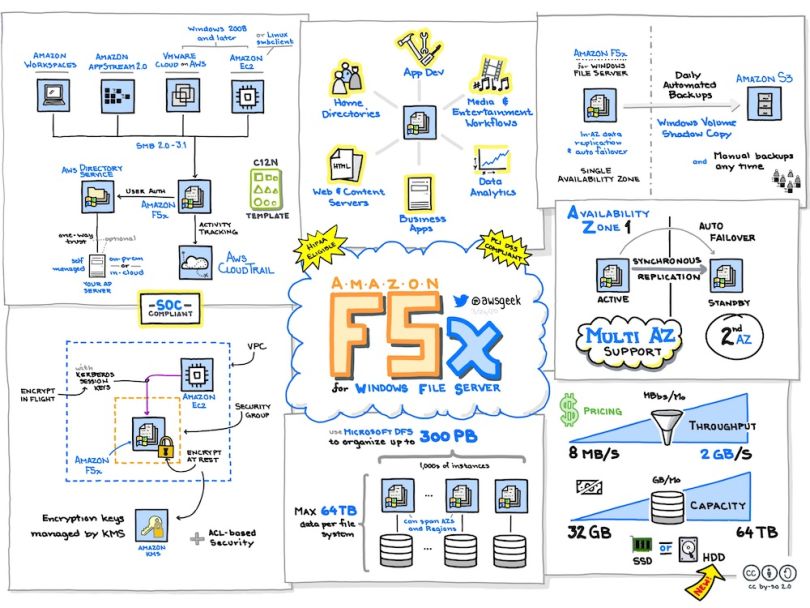The cloud is a tricky product. Though it’s called “the cloud,” it’s not a cloud. Plenty of its users don’t know what it is.
“Really, [it] boils down to a bunch of servers,” Benjamin Gross, an art director who has worked on a handful of cloud marketing campaigns, told Built In. “You can put stuff on the servers and analyze it, [but] nobody really knows where [they] are.”
That’s the beauty of the cloud — clients don’t have to maintain or even visit their data centers. (In fact, they can’t; cloud server farm locations are top secret.) It’s set-it-and-forget-it, invisible infrastructure.
What sort of visuals make sense for a product no one sees?
But this poses some craft challenges for art directors like Gross, working on advertising campaigns for cloud providers. What sort of visuals make sense for a product no one sees?
A quick Shutterstock search turns up “the standard look of cloud computing,” Gross said. “It’s very cold. Everything’s blue. Everything is blue.”
Common tropes include clouds raining glowing strings of code, a la the Matrix; HUD displays, which layer computer data over the users’ field of vision; and nexuses, or interconnected webs of light. (Blue light, obviously.)
“It looks like Minority Report,” Gross said. “Honestly, that’s not a world I want to live in.”
So when Gross worked on an ad campaign for the AWS cloud, he pushed for a move away from sci-fi, blue-lit imagery. At first glance, it looks like the resulting campaign doesn’t have imagery at all.

A Short History of AWS Advertising
For its first decade, Amazon didn’t advertise its cloud to the general public. For growth, the company relied on word of mouth and, as Lowell Anderson, director of product marketing at AWS told Built In, “telling impactful customer stories” — through, for instance, case studies.
“Customers tell us that one of the best ways they learn is from other AWS customers that have worked through or are working through similar solutions,” Anderson explained.
It worked. AWS has been the leading cloud provider ever since it launched in 2006. Today, AWS has cornered about a third of the cloud market, more than its three biggest competitors combined.
“They are cloud computing,” Gross said.
In 2017, though, AWS transitioned and began making “broader awareness plays,” Anderson said, running ads on the MLB’s streaming platform, in airports, at business conferences and beyond, in the hopes of reaching non-technical decision-makers at major companies. Though developers at these companies saw the appeal of the AWS cloud, their superiors leaned skeptical. They instinctively preferred on-premise data centers.
Moving to the cloud, after all, involves moving company data from servers you can see to servers you can’t. Even current cloud evangelists struggled with the idea at first, though, ultimately, they found that the efficiency gains outweighed the loss of control.
“I think everyone’s a little bit creeped out by the cloud to begin with,” Gross said.
Through advertising, AWS could potentially alleviate that knee-jerk reaction, though, building name recognition and trust.
“We don’t feel like we need to do it,” Ariel Kelman, then chief marketing officer at AWS, told GeekWire in 2017. “We think it’s useful.”
The first AWS out-of-home campaign focused on whiteboard sketches and a message that AWS infrastructure makes it easy to build the next big thing; the tagline was “Build on.”
Gross worked on a later campaign, centered on billboards, many of them video-enabled, in and around airports. Taglined “AWS is how,” it was a massive, iterative team effort between his then-agency, Wongdoody, and Amazon’s in-house marketing talent.
The resulting ads look simple enough: 3D text, in the same font Amazon uses for its logos, whooshing across a colorful background.
“It’s not overwhelming,” Gross said — a feat unto itself, given AWS’s thousands of features and tools. (AWS launched 2,345 new features and services in 2019 alone, according to Anderson.)
But if you look closely at the ad’s background, it’s visually complex.
The Art of an All-Text Ad
Some of that background texture comes from Jerry Hargrove, a current architect and evangelist for AWS. He’s spent the past 10 years working for the company, either as an employee or a partner — and, in a volunteer capacity, as an artist. Hargrove draws diagrams of AWS tools and features, and the complex ways they intersect with each other.
It started a few years ago, when Hargrove was an AWS consultant for a company called Rackspace. When he took notes in meetings, they came out more naturally as diagrams than text.
“I’m more of a visual learner,” he told Built In.
Though his diagrams still involve text and labeling, they’re more digestible than an AWS product page, thanks to plentiful white space and intuitive icons. File cabinets might signify storage, in Hargrove’s diagrams, or a lake might signify a data lake.
Initially, he used his diagrams to master the intricacies of the AWS cloud, and explain the product to his clients. But when he posted one on Twitter, it took off. At the time, he had “almost zero Twitter followers”; now he has thousands. (His Twitter handle is, fittingly, @awsgeek.)
“I think they do a really good job of explaining some of what the cloud is trying to do in a simple way,” Gross said, of Hargrove’s diagrams.
Amazon leadership agreed. But Hargrove’s sketches address a somewhat technical audience, already well-versed in the basics of the cloud. Though he does have one diagram titled “What Is Cloud Computing?” (decorated with boughs of holly and elves, because he made it around Christmas-time), he generally focuses on more nitty-gritty topics, like this one of the capabilities of the Amazon FSX for Windows File Server:

Hargrove simplifies his topics, but not quite enough for non-technical leaders rushing through an airport.
So the digital billboards Gross worked on zoomed out even further. They reduced Hargrove’s diagrams — which already distill AWS product pages down to something like a one-sheet — to a translucent background layer. Behind the massive, 3D block text, Hargrove’s whiteboard-esque sketches blend with other easter eggs alluding to AWS’s technical power.
Sharp-eyed viewers might spot “AWS is how,” for instance, the ad campaign’s tagline, written in binary code; and cumulus clouds, or “happy clouds,” as Gross put it — as opposed to the stormy clouds that sometimes appear in stock photography.
It’s an ad for the cloud, after all.
Even the background color, layered behind all these subtleties, looks deceptively simple. It’s a sunset-like gradient, especially in the pinks and oranges of the “Hasta La Vista Data Center” clip — “that kind of fresh pink as the sun goes down,” Gross said, “and then orange haze as the night starts coming over.”
Creating that gradient involved some bulky image files, clocking in at somewhere between nine and 16 gigabytes. A lower-resolution image would result in a pixelated, banded effect, which “looks sloppy,” Gross said.
It also looks artificial, like the lighting in a lot of blue-lit, cliched cloud visuals.
“Why would you make an ad that looks like everybody else’s?” Gross said.

Is a Picture Really Worth a Thousand Words?
The sunlit look of the AWS campaign set it apart. Especially on digital billboards, where the letters could zoom across the screen and grind to a heavy halt, the AWS ads looked an interesting mix of inviting and powerful.
One thing they didn’t look like: the cloud. It’s worth noting that both Hargrove’s sketches and the billboard campaign avoid cliched cloud images — but they also lean more toward text than portraiture. They avoid depicting the cloud at all.
Is it just an impossible task? Should text be the center in cloud advertisements?
It’s definitely a popular choice. Oracle, for instance, has some cloud signage adorned with single words, like “Platform” or “Infrastructure.” Google has run billboards for its Cloud with longer-form text (read: two sentences) and no imagery.
But Gross doesn’t think that the cloud and all-text advertising belong together any more than the cloud and blue light do. With a highly technical, multi-faceted product that no one ever sees in person, like the cloud, the key is “focusing on the benefit to the customer,” he said.
That means less focus on what it is, more on what it can do.
That can involve text, but it doesn’t have to. Amazon has taken a similar approach, recently, in a series of character-driven TV spots featuring curious kids.
“How do they make shoes like that?” a young girl asks, entranced by an Adidas sneaker displayed on a pedestal.
“How do you always find the best stuff to watch?” she asks her mom, as they stream Netflix one night.
The answer, in the ending tile: “AWS is how.” There’s minimal text onscreen until then, though; the ads hinge on scenes, herky-jerky kid motion, and human interaction.
All of this is has been rare in cloud advertising so far. It can feel like “an impossible product,” Gross said, “to deal with in a human way that [feels] inviting.”
It’s not, though. At the very top of the sales funnel, cloud advertising can be about natural lighting and simplicity and (literal) child-like wonder — not hulking servers in dark, placeless warehouses. Even though that’s what it is.
“Do you really want to go into what a server is?” Gross said. “Nobody cares.”
At least, not until smart marketing sparks their curiosity.




